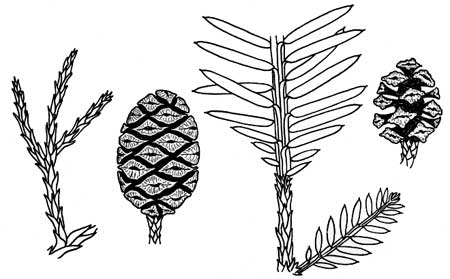|
The Redwoods of Coast and Sierra
|

|
|
REPRODUCTION OF THE REDWOODS Sierra Redwood—reproduction by seeds.—The opinion has long been held, particularly in popular literature, that the Sierra Redwood is not reproducing itself. This opinion is true in part in the northern groves, where in most places the humus cover appears to be too dry to favor the germination of seeds; it is not true, however, in the groves farther south. Reproduction is most abundant in the southern groves in and around Sequoia National Park. Male and female cones are borne on the same tree. Flowering takes place between February and April, or sometimes as late as May. The seeds develop in the female cone and reach maturity at the end of the second year. Cones and seeds are produced in abundance; in fact, the Sierra Redwood is one of the most prolific trees of the cone-bearing class. Each cone contains between 150 and 250 seeds, from 3 to 8 small seeds being borne at the base of each scale of the cone. The seeds ripen from August to November. Ordinarily, cones remain on the trees for some years, and seeds are shed before the cone drops. The cones containing seed which are found on the ground have usually either been dropped by squirrels or blown down by heavy winds. Twenty-four-year-old saplings have been known to bear cones, when growing under full light conditions, but greenhouse tests have shown that such cones contained only infertile seeds. It is probable that, as a rule, good seeds do not develop on trees that are less than about 200 years of age. The Redwood trees produce fertile seed much later in life than do many other species of trees. The Sierra Redwood seed is small, flat, and very light, and it requires mineral soil for successful germination. The vitality of the seed persists for two or three years. Approximately 15 in 100 of the seeds are fertile. The young seedlings need light and some soil moisture as well as mineral soil. Seedlings grow slowly the first year, but make quite rapid development for two or three years thereafter. They begin to branch vigorously from the first year, and soon assume the characteristic pointed form of the young trees. Young trees have grayish bark, and pointed, prickly leaves which are more scattered along the branch than in the adult trees. Branches often cover the tree from the ground to the top of the tree.
Reproduction is abundant in all the National Parks. In the spring of 1935, more than 10,000 seedlings were counted near the Big Trees Lodge of the Mariposa Grove, where mineral soil had been exposed. The seedlings often grow in thick stands, and after a few years some of them are shaded out and die. Coast Redwood—reproduction by seeds and stump sprouts.—Seeds of the Coast Redwood develop in small cones which are about one-fourth the size of the cones of Sierra Redwood. The cones mature at the end of the first year. From 50 to 60 small seeds develop in each cone. Dr. Jepson, in his Silva of California, gives an excellent description of the method of reproduction: Reproduction [of the Coast Redwood] is by means of seeds and stump sprouts. While seeds are produced in enormous quantities seedlings are a great rarity in the Redwood Belt, the densely shaded forest and the ground litter of foliage, often one foot thick, offering most unfavorable conditions for germination. Moreover a large percentage, 60 to 75 per cent, of the seeds are not viable. . . . Reproduction by stump sprouts is the usual method found in the thick Redwood forests. The Coast Redwood, to quote again from Dr. Jepson's Silva of California, is the only strictly coniferous species which has this habit. The tree has no tap-root, but a large number of huge lateral roots which lie near the surface of the ground at their point of origin, a most advantageous position to generate by adventitious buds a circle of sprouts about the stump. The sprouts are usually numerous, sometimes a hundred or more. These form a second generation which, reduced in number by competition, are eventually represented by a circle of trees. |
| <<< PREVIOUS | CONTENTS | NEXT >>> |
The Redwoods of Coast and Sierra ©1940, University of California Press shirley/sec7.htm — 02-Feb-2007 | ||
